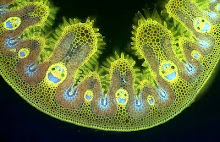I know some people who think that Hydrangea flowers are more attractive when dead that alive. It's a sentiment that I have some sympathy with...
... because I don't find the heavy, long-lasting infloresences of mop-headed Hydrangea macrophylla cultivars particularly attractive, but when winter has done its work on the dead flower heads the skeletonised florets, like those in the first photograph, are transformed into something rather delicate and beautiful.
Hydrangea infloresences are an interesting example of division of labour, where the central mass of short-lived fertile flowers, bearing stamens, stigmas and ovaries, have no particular visual advertising to attract insects but devolve that job to the large sterile florets, that surround the edge of the inflorescence like orbitting satellites. Petals wilt as soon as a flower is fertilised but since that outer ring of sterile advertising florets can never be fertilised they last indefinitely, throughout the whole flowering period and often right through the winter as skeletonised petals.

The arrangement is delightful in some of the larger species like H. aspera (also known as H. villosa) when it's grown in an open, woodland garden.

Hydrangea infloresences are an interesting example of division of labour, where the central mass of short-lived fertile flowers, bearing stamens, stigmas and ovaries, have no particular visual advertising to attract insects but devolve that job to the large sterile florets, that surround the edge of the inflorescence like orbitting satellites. Petals wilt as soon as a flower is fertilised but since that outer ring of sterile advertising florets can never be fertilised they last indefinitely, throughout the whole flowering period and often right through the winter as skeletonised petals.

The arrangement is delightful in some of the larger species like H. aspera (also known as H. villosa) when it's grown in an open, woodland garden.

Advertising all those fertile florets with just a handful of sterile florets is a very efficient way for the plant to attract its pollinators, but it's hardly surprising that plant breeders have hybridised and selected species for large numbers of sterile, long-lasting florets for maximum impact in a shrub border, reversing nature's economical use of advertising in the quest for maximum visual impact.
















